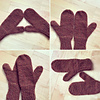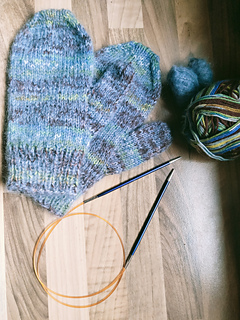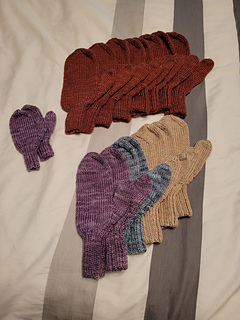patterns >  Helen Mawdsley's Ravelry Store
Helen Mawdsley's Ravelry Store
> Helen's Mittens














Helen's Mittens
I am re-releasing this pattern at the end of 2020 as a free pattern for all. It seems folks have started to become curious about exploring arts and crafts and developing their personal skills in these areas, and I hope that this pattern adds to that momentum. In addition, I would like to encourage using this pattern for making donation and charity mittens.
I developed this pattern many, many years ago when I taught knitting at a local yarn store so that I could offer my students a free mitten pattern while attending my class. In this version, I have expanded some of the instructions and offered pictures. While this is not a replacement for in-person instruction, I hope that it can help you, as you work through this pattern.
The mitten is knit from the cuff to the top, with an ambidextrous thumb placement, rather than a specific left or right thumb placement.
Materials
• 50gm/120m/132 yds of DK yarn, sample here used New Lanark Wool, Autumn colourway
o Approx 35 gm for small size
o Approx 40 gm for medium size
o Approx 45 gm for large size
• 3.25mm needles (US size 3)
• 4mm needles (US size 6)
• Stitch marker, stitch holder, tapestry needle
Sizing
The pattern instructions are written for small (medium, large), which could also be described as older child (average adult, larger adult).
Tension
22 sts = 10cm/4in in stockinette
Once you are comfortable with this pattern, consider trying it on thicker or thinner yarn. I have written this pattern in a way that can be amendable to different shapes of hands as well as different types of yarn. (For example, knit hand until it is at the end of the pinky finger, etc.). If you are using thicker yarn (and larger needles) cast on fewer stitches, and if you are using thinner yarn (and smaller needles) cast on more stitches. Keep in mind that there should be an even number of stitches on the hand, so that the front and back of the mitten will be even. This pattern can also be knit in stripes, or have a little bit of colour work added in. Maybe even a little bit embroidery or other embellishments can be added too.
1678 projects
stashed
1189 times
- First published: March 2012
- Page created: December 31, 2020
- Last updated: March 17, 2022 …
- visits in the last 24 hours
- visitors right now




